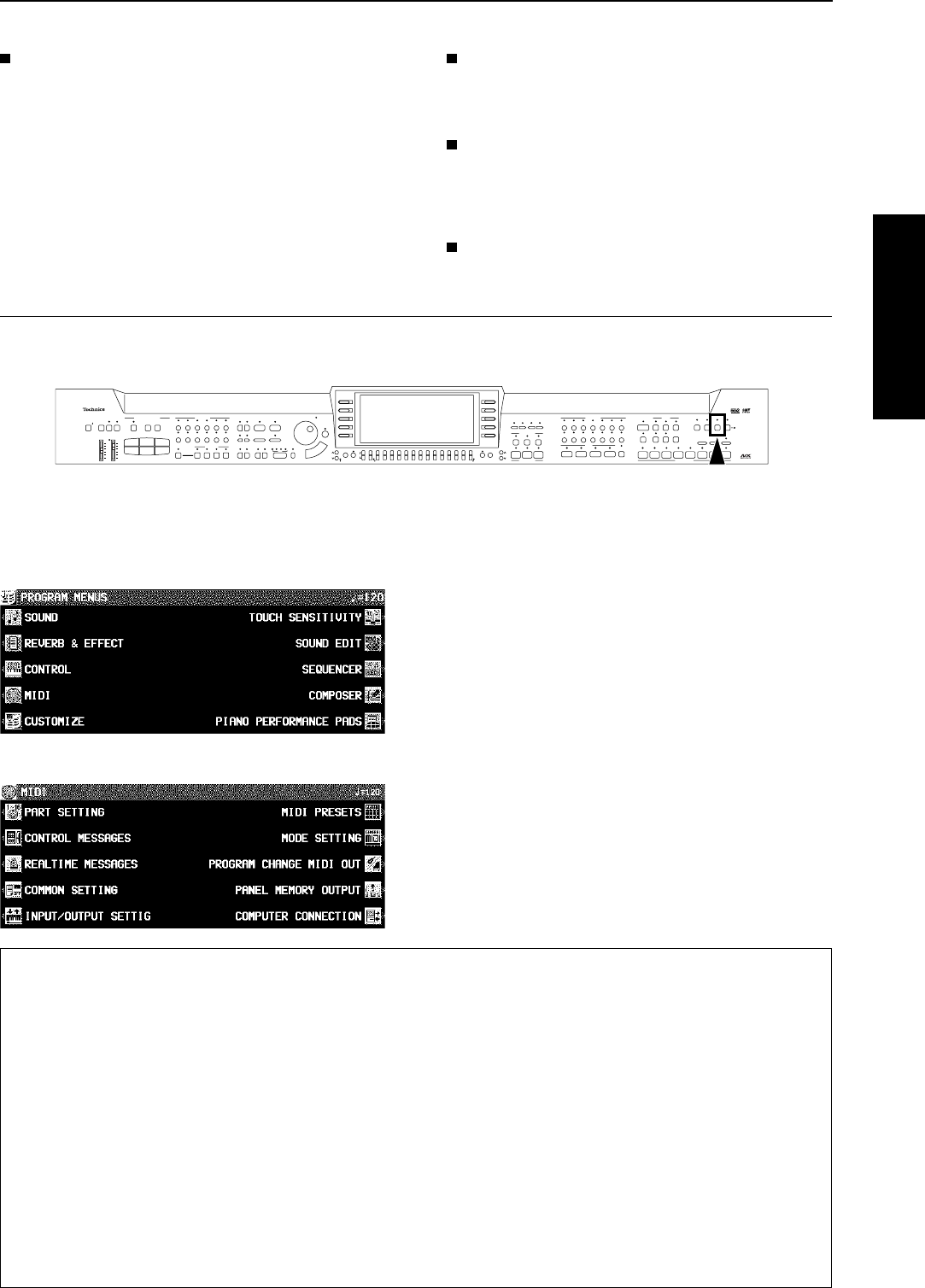
The following kinds of data can be transmitted/received.
NOTE data
This is the most basic kind of MIDI data which is exchanged,
and is used to specify which keys are played and how hard
they are played.
NOTE NUMBER: Number specifying which key is played.
NOTE ON: Specifies that a key is played.
NOTE OFF: Specifies that a key is released.
VELOCITY: Specifies how hard a key is struck.
• MIDI notes are assigned numbers from 0 to 127, with middle
C (C3) as 60. Note pitches are in semitone increments,
with the higher numbers assigned to the higher pitches.
PROGRAM CHANGE
This is sound change data. When a different sound is selected
on the transmitting instrument, the sound on the receiving
instrument also changes.
CONTROL CHANGE
These are volume, sustain, effect, etc. data used to enhance
performance expression. Each function is distinguished by
its control number, and the function which can be changed
by the control differs depending on the instrument.
EXCLUSIVE data
This is data that is specific to this instrument, and data for
the GENERAL MIDI LEVEL 2 mode setting.
Outline of MIDI functions
1. Press the PROGRAM MENUS button to turn
it on.
• The display looks similar to the following.
2. Select MIDI.
• The display looks similar to the following.
3. Select a function.
4. Follow the procedure to adjust the settings.
• While you are adjusting the settings, when the
TEMPO/PROGRAM indicator is lit, it indicates that the
TEMPO/PROGRAM is available for setting the current
function.
5. When you have finished setting the functions,
press the PROGRAM MENUS button to turn
it off.
DEMO
SPLIT
POINT
MAIN
VOLUME
APC/SEQUENCER
VOLUME
MODE
CHORD FINDER
OFF/ON AUTO SETTING BANK STOP
8&16
BEAT
ROCK & POP BALLAD JAZZ & SWING
MOVIE &
SHOW
SOUND
ARRANGER PIANO STYLIST
TEMPO / PROGRAM
PROGRESSIVE
PIANIST
ONE TOUCH
PLAY
SIMPLE PIANOFADE
IN OUT
INTRO & ENDING
START / STOP
SYNCHRO
START
TAP TEMPO
FILL IN
12 1
1234
BEAT
2
METRONOME
SET OFF/ON
1234
VARIATION
MUSIC STYLE
ARRANGER
GOSPEL
& BLUES
SOUL &
DISCO
COUNTRY &
WESTERN
LATIN &
WORLD
MARCH &
WALTZ
MEMORY
LOAD
123
456
MAX
MIN
MAX
OFF
SOLO SOLO
RHYTHM GROUP
SAX &
WOODWIND
ORGAN &
ACCORDION
SOUND
EXPLORER
BRASS SYNTH SOLOIST
MULTI EFFECT
CHORUS REVERB PLAY EASY REC
SET NEXT BANK BANK VIEW
PROGRAM
MENUS
DISK
LOAD
CHORD STEP REC
DISK
IN USE
SOLO
TECHNI-CHORD
DIGITAL EFFECT BRILLIANCE
STRINGS
TRANSPOSE R1/R2 OCTAVE
–
PART SELECT
CONDUCTOR PANEL MEMORY
LEFT RIGHT 2 RIGHT 1
LEFT RIGHT 2 RIGHT 1
+ – +
GRAND UPRIGHT ELECTRIC MODERN
12345678
DIGITAL
DRAWBAR
VOCAL BASS
DRUM KITS MIXTURES MEMORY
GUITAR
& HARPSI
MALLET &
ORCH PERC
SOUND GROUP EFFECTTHEATRE SONIC
SEQUENCER
PIANO
PIANO PERFORMANCE PADS
AUTO PLAY CHORD
FAVORITES
OTHER PARTS/TR
HELP
DISPLAY HOLD
EXIT
LCD CONTRAST PAGEMUTE
SEQUENCER
RESET
COUNT
INTRO
SX-PR804
Summary of the MIDI menu items
PART SETTING (page 128)
Set the MIDI CHANNEL, OCTAVE and LOCAL CON-
TROL settings for each part.
CONTROL MESSAGES (page 129)
Enable or disable the exchange of various CONTROL
data.
REALTIME MESSAGES (page 129)
Enable or disable the exchange of REALTIME COM-
MANDS, and select the CLOCK mode.
COMMON SETTING (page 130)
Set the functions which are common to all parts.
INPUT/OUTPUT SETTING (page 131)
Settings which determine how various performance
data is treated during data transmission and recep-
tion.
MIDI PRESETS (page 132)
Establish the optimum settings depending on how
this instrument is connected to other equipment.
• You can save the settings you specify yourself.
MODE SETTING (page 131)
NX SOUND and GM LEVEL 2 ON setting
PROGRAM CHANGE MIDI OUT (page 133)
Settings for transmitting the desired PROGRAM
CHANGE data on the specified MIDI channel.
PANEL MEMORY OUTPUT (page 133)
Settings that affect the transmission data when the
PANEL MEMORY buttons are operated.
COMPUTER CONNECTION (page 134)
Mode settings related to the flow of MIDI signals
when this instrument is connected to a personal com-
puter.
MIDI
Part XII MIDI
127
QQTG0665
